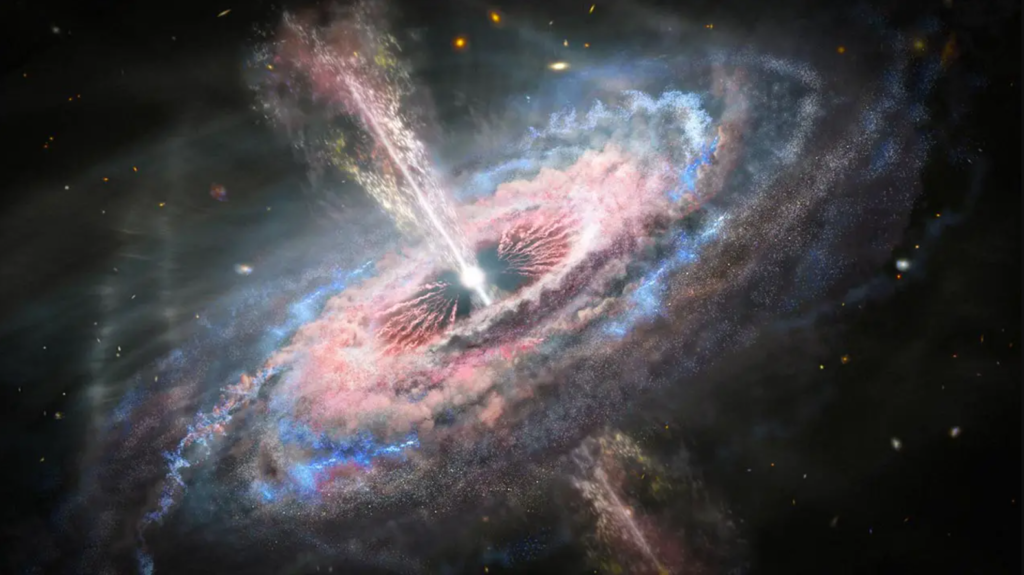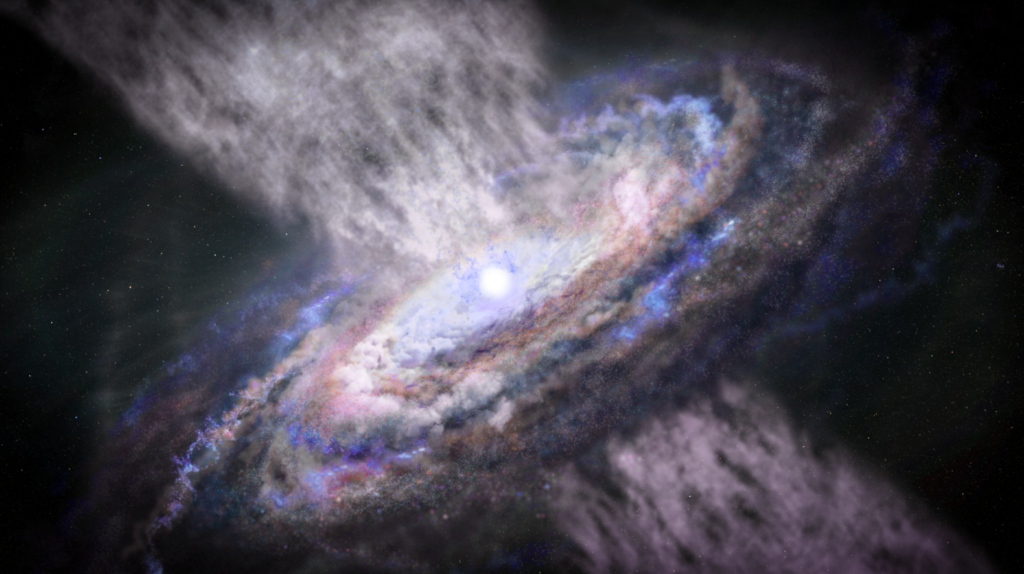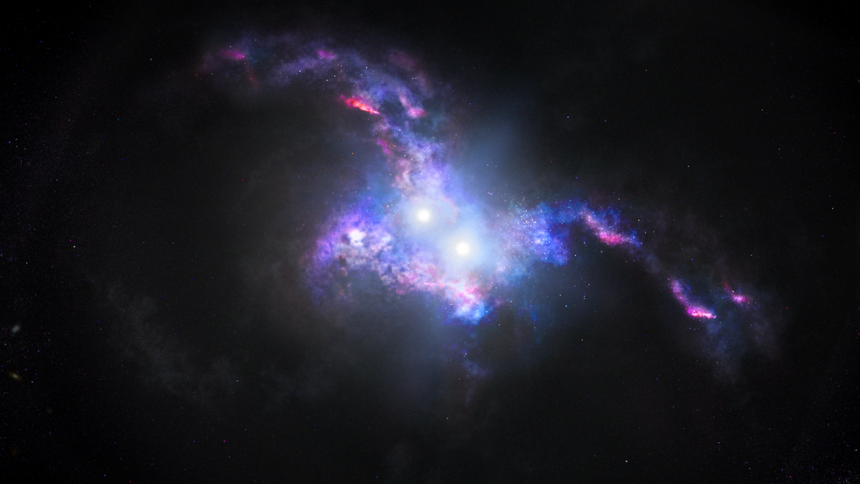In the vast expanse of our universe, some of the most enigmatic and powerful phenomena are black holes. These cosmic entities, with their immense gravitational pull, have fascinated scientists and astronomers for decades. Recent discoveries involving ancient quasars and their association with massive dark matter halos are shedding new light on the secrets of black holes. In this article, we delve into these discoveries and their implications for our understanding of the universe.
The Mysterious World of Quasars
Quasars are incredibly bright and energetic objects found at the centers of galaxies. They are powered by supermassive black holes that gobble up surrounding matter, emitting intense radiation in the process. Quasars are like cosmic beacons, visible across vast cosmic distances. Their light travels billions of years to reach us, giving us a glimpse into the universe’s distant past.
Ancient Quasars and Their Significance
Recent observations by astronomers have focused on ancient quasars, some of which existed just a few hundred million years after the Big Bang. These quasars are essential cosmic time capsules, offering a window into the universe’s infancy. They provide valuable insights into the conditions of the early universe, its chemical composition, and the growth of supermassive black holes.

The Connection with Dark Matter Halos
Dark matter is an elusive and invisible substance that makes up a significant portion of the universe’s mass. It exerts gravitational influence on visible matter, like galaxies, stars, and gas clouds. Recent studies have shown that ancient quasars are closely associated with massive dark matter halos, regions where dark matter density is high.
Understanding the connection between quasars and dark matter halos is crucial because it sheds light on the coevolution of galaxies and their central supermassive black holes. These findings suggest that the growth of supermassive black holes is intimately linked to the surrounding cosmic environment.
The Cosmic Web Unveiled

The cosmic web is a vast, interconnected structure formed by dark matter filaments that weave throughout the universe. Recent research indicates that quasars, especially those from the early universe, tend to align along these cosmic filaments, emphasizing the profound interplay between dark matter and quasar formation.
This alignment offers crucial information about how cosmic structures evolve over time. It also highlights the pivotal role of dark matter in the distribution of galaxies, quasars, and, by extension, supermassive black holes.
Implications for Black Hole Research

The discoveries related to ancient quasars and their connection to massive dark matter halos have several profound implications for black hole research:
- Black Hole Growth: Understanding the relationship between supermassive black holes and their surrounding environments is vital to comprehending how these cosmic behemoths grow and evolve.
- Cosmic Evolution: The alignment of quasars along cosmic filaments suggests that dark matter plays a significant role in shaping the distribution of galaxies and black holes throughout the universe’s history.
- Early Universe Insights: Ancient quasars offer a unique glimpse into the conditions of the early universe and the processes that led to the formation of supermassive black holes at its centers
- The Enigmatic Nature of Black Holes
- Black holes remain some of the most mysterious and intriguing entities in the universe. These regions of spacetime where gravity is so intense that nothing, not even light, can escape their grasp, continue to challenge our understanding of the fundamental laws of physics. While we have made significant strides in uncovering their secrets, there is still much to learn.
- One of the key mysteries surrounding black holes is the process by which supermassive black holes form and grow to colossal sizes. Ancient quasars provide a critical piece of this cosmic puzzle. These early quasars are thought to contain some of the most massive black holes ever observed, challenging current models of black hole formation and growth.
- The Role of Feedback Mechanisms
- One of the most exciting implications of the connection between ancient quasars and dark matter halos is the role of feedback mechanisms in the cosmic ecosystem. As supermassive black holes at the centers of galaxies accrete vast amounts of matter and emit intense radiation, they can influence the surrounding environment.
- This feedback can have profound effects on the formation of stars and galaxies. The energy and radiation emitted by quasars can either stimulate or suppress the birth of new stars, shaping the evolution of galaxies over cosmic timescales. Understanding these feedback processes is essential for comprehending the coevolution of galaxies and their central black holes.
- The Search for Answers Continues
- As astronomers and astrophysicists continue to study ancient quasars and their association with dark matter halos, they are working towards unraveling some of the most profound questions in cosmology:
- Black Hole Birth: How did supermassive black holes form so rapidly in the early universe? What processes facilitated their rapid growth to become the cosmic giants we observe today?
- Galactic Evolution: What impact does the presence of supermassive black holes have on the formation and evolution of galaxies? How do feedback mechanisms influence the cosmic web of matter and dark matter filaments?
- Fundamental Physics: The study of black holes, both at cosmic and microscopic scales, continues to challenge our understanding of the laws of physics. Discoveries related to ancient quasars offer critical insights into the interplay between gravity, electromagnetism, and quantum mechanics.
CONCLUSION
The recent revelations concerning ancient quasars and their connection to massive dark matter halos have opened up new avenues of exploration in the field of astrophysics. These discoveries provide a unique glimpse into the early universe and its most powerful and enigmatic inhabitants: supermassive black holes.
As our scientific instruments and theoretical frameworks advance, we can anticipate even more profound insights into the nature of black holes, dark matter, and the intricate tapestry of the cosmos. The journey to unlock the secrets of the universe is ongoing, and the study of ancient quasars and their cosmic relationships is a testament to humanity’s insatiable curiosity and the boundless wonders of the cosmos.
ALSO READ: Comet Nishimura: A Celestial Spectacle In The Night Sky In 2023




































